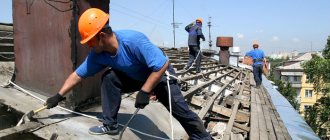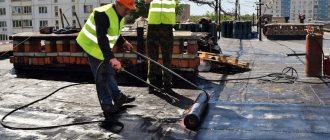The concept of “current repairs”
A number of legislative acts adopted in the Russian Federation help to clarify the term “current repairs”. These include the Decree of the State Construction Committee of the Russian Federation dated September 27, 2003 No. 170 “On approval of the Rules and Standards for the Technical Operation of the Housing Stock”, Urban Planning Code of the Russian Federation.
The definition of “routine repair” characterizes systematic work related to the correction of minor defects and malfunctions.
The goal is to maintain the building’s engineering structures in working condition. Activities include lists of work to replace or repair existing equipment, strengthening it in order to prevent further destruction. An example is strengthening a roof structure by adding rafters.
Current repairs have the following features:
- planning. The plan is drawn up several years in advance after inspecting the entire territory and taking inventory of the main structural elements;
- systematicity. Only constant maintenance of the building and its engineering structures in working condition increases its service life.
Preventive measures are carried out by the campaign manager or contractor.
This type of work can be not only preventive, but also urgent and unforeseen. Its goal is to urgently eliminate a newly identified defect for the purpose of restoration. Problems are discovered by the residents of the house personally or identified during ongoing repair work.
What does the legislation say?
The legislation provides space for a description of each type of repair work that can only be carried out in relation to the common premises of homeowners, which means that there are differences between repairs and major repairs.
Not only employees of the management organization should be familiar with these legislative acts in order to properly organize activities for the maintenance of common property, but also apartment owners.
The fact is that sometimes dishonest employees of management organizations pass off one type of activity as another, thereby trying to profit from the owners’ ignorance of the difference in prices and volume of activities. Also, work to maintain the house in a well-maintained condition can be carried out with a significant delay or even skipped altogether.
Let's turn to the legislation. The Town Planning Code of our country, in its article, Article 1, paragraph 14.2, talks about what constitutes a major overhaul.
What repairs are considered major repairs? Carrying out such actions involves either replacing or restoring (and in some cases simultaneous) intervention in the structure of the house and the general engineering and technical support of an apartment building.
Thus, we can conclude that the work carried out as part of the overhaul is global in nature and interferes with the internal structure of the house. This is the main difference between major and current repairs.
The concept of routine maintenance differs significantly from the above. What is the average current repair? You can become familiar with this concept within the framework of the Methodological Guide for the Maintenance and Repair of Housing Stock in Article 3, paragraph 5.
There is also Resolution 279 on major and current repairs, which can be downloaded below. In it you can also find out what applies to current repairs and what to major ones.
The concept of major repairs and current repairs: major repairs are repairs in order to prevent wear and tear on the house and carry out global work. Carrying out ongoing activities are planned actions that are carried out in order to maintain the normal condition and performance of the house.
It would seem that it is very easy for an ignorant person to get confused about what actions are currently being taken on the house. In addition, not every owner knows how often certain repairs should be carried out.
Let's try to understand the differences in order to understand major repairs and current repairs. What is the difference? Is roof repair a major repair or a routine repair? Read more about the technical regulations and SNiP standards for repairing the roof, as well as major and current roof repairs here.
The concept of "overhaul"
A major overhaul has larger tasks than the current one.
Implies restoration or complete replacement:
- Building design elements.
- Engineering systems.
- Communications.
The goal is to eliminate the wear and tear of the building that affects the functioning of the systems.
Capital work is manifested in a complete redevelopment of the building, installation of new utility networks that are stronger and more reliable, modernization of existing equipment, but not in the construction of new extensions.
By type it is divided into:
- comprehensive overhaul;
- selective overhaul.
In the first case, a one-time restoration of worn-out elements of the building occurs. It is carried out for buildings whose structural elements (with the exception of the foundation, walls and support pillars) have become unusable. Selective is suitable in situations where the building is in satisfactory condition, but it is necessary to carry out a deep reconstruction of one or two types of work, for example, replacing the roof or repairing the facade.
The goal of a major overhaul is not to partially maintain the house in good condition, but to restore characteristics as close as possible to the new building.
Examples of work are:
- complete renovation of the exterior of the house;
- replacement of in-house engineering systems, for example, heating pipes, sewer, electrical networks.
The peculiarity of the work is that it is carried out in a complex, simultaneous updating of all systems of one building.
Walls and foundations, as load-bearing supporting structures, are considered not subject to major repairs. Their wear and tear leads to the recognition of the house as subject to demolition or complete reconstruction.
Frequency
As mentioned earlier, each engineering system of an apartment building has its own service life. This information is clearly displayed in the technical regulations, which read as follows:
- Central heating system - 25 years.
- Replacement of hot water supply risers during major repairs - 30 years (if the risers are not galvanized, then 15 years).
- Cold water supply risers - 30 years (if the pipes are not galvanized, then 15 years).
- Overhaul of the power supply system - 20 years.
- Sewerage - 60 years (if the pipes are ceramic or plastic) and 40 years (if the pipes are cast iron).
- Roofing - depending on the material. Accordingly, a roof made of slate lasts 30 years, one made of galvanized steel - 15 years, and one made of rolled materials - about 10 years.
The above figures are the wear and tear of the main engineering systems of the building. Accordingly, capital work must be carried out after this period, including a complete replacement of the structural components of each system.
We wrote about the frequency and procedure for major building repairs here.
Differences between the two types of work
The similarity of the concepts makes it possible to confuse the two types of work.
The difference between a major overhaul and a current one is easy to understand when comparing the criteria:
| Criterion | Maintenance | Major renovation |
| Cost | Costs less | Requires a lot of money |
| Periodicity | Annually as needed | On average once every 15-25 years |
| Conducted by whom | Management company, HOA or citizens managing the house themselves | A management company, HOA or citizens managing the house independently or under an agreement - a contractor |
| By type of work: Foundation | Repair and strengthening in parts | Complete repair around the perimeter |
| Roof | Strengthening rafters, eliminating coating defects if the roof begins to leak, repairing gutters | Restoring functional abilities by replacing the covering, rafters, sealing, and insulation |
| Building's facade | Correction of architectural elements, repair of joints (if deformed), waterproofing, painting | Complete façade finishing, possibly with material replacement |
| Elevator | Troubleshooting current problems | Complete repair or replacement of the elevator shaft and equipment |
| Doors and windows | Replace individual components as needed | Replacement |
| Engineering systems | Partial replacement or strengthening of existing deficiencies | Restoration work |
Current repairs are accompanied by such actions as repair, replace, strengthen, repair, and change the appearance. They do not make radical changes; they eliminate the manifestation of a specific problem that has arisen.
A major overhaul is more thorough and in-depth. Affects several interrelated elements of the house at once.
To understand how the current repair of an elevator differs from a major one, you need to understand that the elevator belongs to common property. This is defined in legislation, law 185-FZ of July 21, 2007. It is used by owners of residential apartments living in them under rental agreements, and owners of non-residential premises. If there is a document - an act indicating that the elevator shaft, lift or electric motor cannot be repaired in the current order - major work is carried out. Most often, overhaul is necessary after 5-15 years of operation. Freight and passenger elevators are operated differently in terms of intensity and load capacity. The repair period also depends on the quality of the current scheduled repair work on elevator equipment, especially when it comes to the electric motor.
Current and major repairs in the local area have the following goal - giving an aesthetically pleasing appearance. But they differ according to additional criteria.
Ongoing work will consist of:
- partial restoration of the sidewalk and lawn;
- improvement of passages for transport, internal roads for cars;
- painting playgrounds;
- repairing water wells.
At the same time, capital work will consist of complete restoration of the road, restoration of playgrounds, and repair of fences.
Financing difference
Financing all types of work is not an easy task. Depends on the type of work performed and the type of construction. A private home is repaired only at the expense of its owner. In an apartment building we are talking about the common property of the owners.
Article 44 of the Housing Code of the Russian Federation (LC RF) determined that at a general meeting of owners of a residential apartment building, a decision is made to carry out repairs and issues with financing are resolved. You should be aware of the significant differences characteristic of the material support for capital or routine repairs of common property in a multi-storey building.
The costs of ongoing work are low. They are made at the expense of funds transferred monthly by each owner of residential premises in the house, according to the column maintenance of residential premises. The money is accumulated in a special account of the management company and has a specific purpose - ongoing repair work. The account is replenished by income received from renting out part of the premises in the house, for example, shops on the ground floors.
80% of the money from the fund is spent on planned work, the rest is saved for unforeseen work.
Major repairs according to clause 2 of Art. 158 of the Housing Code of the Russian Federation is paid based on the decision made at the meeting of home owners. Representatives of the management company are present at the meeting and will outline a complete work plan. The rate for major repairs is determined at the level of government of the subject.
The fund is replenished by monthly contributions under the capital repairs column. The accumulated money supply becomes the basis for creating an estimate for repairs. State subsidies play an equally important role, although they are not always provided. The place where the fund is formed plays a big role. If this is a management organization, then the repairs are carried out only at the expense of the owners of the house; the management company is obliged to pay the bills. If she has the material and technical base, she can carry out the work independently. Transferring funds to a regional operator changes the order. The regional operator enters into an agreement with a contractor to carry out work.
When accounting for funds in the Management Company, they are divided by sources of financing. Accounting is different when transferring money from a budget organization or owners/tenants of premises in an apartment building. The tax accounting of funds received is also different. All accounting transactions can be checked for the purpose of open discussion of the results or progress of repair work.




